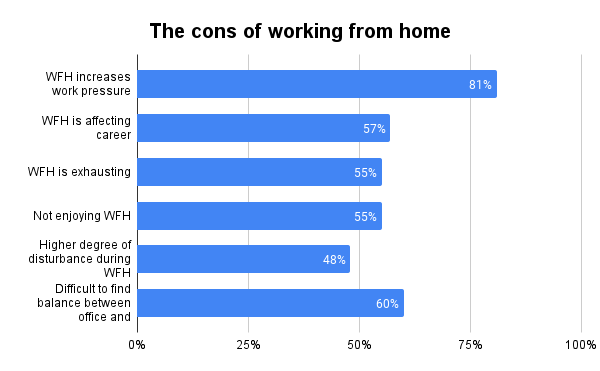Work-from-home or Work-from-office: Survival of the fittest
With the world shifting back to the pre-pandemic scenario, the question of whether companies must return to work-from-office or continue with the work from home model lingers. A hybrid model promises the best of both worlds, but would it be an ideal choice?
- The work from home model has been setting a new trend for the work culture post the COVID-19 pandemic.
- The advantages of the work-from-home model are multi-faceted such as saving time & cost for employers & employees.
- At the same time, the urge to work from the office for most people is an implication of monotony and a stringent work-life balance.
- Many surveys suggest that a hybrid-work model can be the ‘new work-life culture’ amidst the recovery phase from the pandemic.

Image credit: Shutterstock
According to a survey carried out by TeamLease in May 2022, nearly 58% of organizations, ranging from FMCG and BFSI to healthcare, retail and IT, believed that 2022 will become the year of a complete on-site working model. Only 5% of respondents expressed a desire for working from home even after the removal of COVID-19 restrictions.
Executives at multiple companies across India confirmed that they will continue with the flexible working model, which was adopted during the pandemic to manage operations. Some big names like Tata Steel and Mondelez even said that they are hiring candidates for permanent remote roles. On the other hand, companies like ITC, Maruti Suzuki and Mphasis are adopting hybrid working models, where employees only need to attend the office for a couple of days a week.
Decoding the work-from-home culture
Starting from March 2020, a number of employees settled into a comfortable work-from-home routine and want it to continue. Conversely, there is a significant number of employees who want to return to office. Part of the reason for this divided opinion is the work culture a company offers to its employees, and if travelling to office is worth the time and cost.
So, let’s find out if work-from-home has been merely a short-term trend or if it shall continue to be part of the corporate culture. Before we dig deeper into the discussion, let us first understand the pros and cons of this model.
Pros of a WFH Model
Work-life balance
Apart from the cost savings on administrative and real estate expenses, the work-from-home model offers both employees and employers greater flexibility to work as per their comfort and convenience. In a household, where both the husband and wife are working, they can share the burden of domestic work together. This helps them bond better.
According to recruiters, one of the most common issues for employees is travel. Several employees were needed to relocate to other states or cities for employment and be away from their families, but a lot of them cherish the opportunity to work from home in comfort.
Impact of digitization
With the advent of technology like AI and VR along with easy access to facilities like internet, certain occupations that previously couldn’t be done remotely may now be done from anywhere. Sales and operations are some good examples of such jobs, where client interactions and demos can be done through digital interfaces. Not just that, but routine work can also be automated completely through advanced automation.
All of this would not be possible without the technological advancements in the country. This is perhaps the biggest reason behind adopting work-from-home culture on a greater level and it is safe to say that it won’t go easily.
Climate, cost & convenience
Working from home also provides the convenience of connectivity as well as having the leisure time to connect with friends and family. Also, as of the recent trends, the working culture now opts to travel from one city to another as they can work from anywhere in the world, while they do not have to worry about unpaid leaves. The model also proves to be easy on the pocket, as it saves travelling costs, besides less traffic on the road, is exactly what the world needs to expedite climate control.
Cons of a WFH Model
If the work-from-home model has so many perks, then why do a big chunk of employees want to work from their office? The below graph has the answer:

Source: Statista 5,842 employed respondents (approx. 75% respondents under 39 years of age)
A whopping 81% of respondents stated that the work-from-home model increases the work pressure, while 55% didn’t simply enjoy working with this culture. A World Economic Forum survey has found that the average productivity of home workers has increased but is still lower than that of the usual workplace.So, this model has its downsides, especially in terms of technology and infrastructure.
Further, most homes in India have 2 bedrooms, and many employees live in huge joint families as well. In this scenario, setting up an office environment at home becomes extremely challenging. Apart from physical space constraints, around 48% of employees experience a higher degree of disturbance during their working hours because of family members and other household chores. Moreover, employees feel like their personal space is being intruded upon by this arrangement.
Working from the office carries the advantage of having a fixed number of hours. Employees can enjoy leisure time after work in a relaxed way. However, this is not always possible with the WFH model. It takes a mental as well as physical toll on the employees.
Besides, the fact that not everyone can afford Wi-Fi connectivity or conveniently work from their home due to disrupting the environment, lack of concentration, etc, adds to why a large section of the population is not comfortable with this model. In fact, 60% of the people, as stated in the data, feel that balancing working from home along with managing the house is much trickier.
Hybrid model: The best of both worlds?
In the latest survey performed by CBRE South Asia Private Limited, around 73% of Indian companies are considering continuing with the hybrid working model after the pandemic. The reason behind this is revealed to be the emerging trend of flexible working models across the world. This survey clears that the hybrid model is a combination of four arrangements. These patterns include remote work under particular circumstances, 3 or 4 days from office, equal days from home and office, and WFH for 3 or 4 days a week.
Talking about the renowned companies working on this model, Maruti Suzuki is among the frontrunners. According to Rajesh Uppal, Head of Human Resources at Maruti Suzuki, the largest automaker in the nation, hybrid working has been institutionalized in places where it is feasible. He also mentioned that the primary goal of the company is maintaining staff health and safety along with increasing operational efficiency. Many other companies also believe that providing a flexible working environment to their employees helps them to increase productivity and efficiency irrespective of the place they are working.
As we can see from the above data and statistics mentioned in this article, there are both benefits and drawbacks of the work-from-home model. It was primarily started to deal with the pandemic situation but was later adopted as a worldwide trend. While some employees are enjoying its positives, some are greatly affected by it negatively. In this scenario, the hybrid working model can be seen as a common ground between both and is offering benefits to both worlds. This is the reason why it is largely adopted by an increasing number of organizations in India. As far as the future of WFH culture is concerned, it is here to stay looking at the greater efficiency and productivity it provides.













Leave a comment